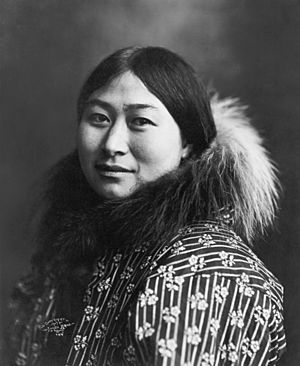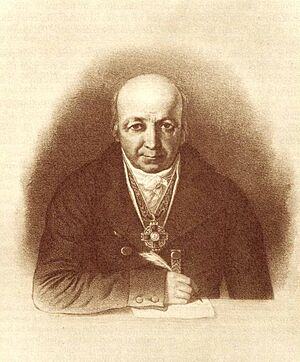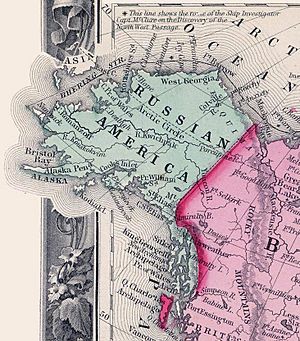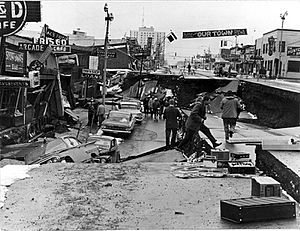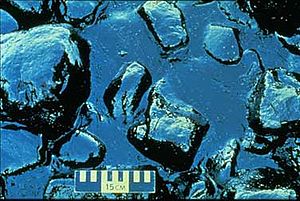History of Alaska facts for kids
The history of Alaska goes way back to the Upper Paleolithic period, around 14,000 years before Christ. During this time, groups of hunter-gatherers crossed the Bering land bridge into what is now western Alaska. When Russian explorers first arrived, many different Alaska Native groups lived there. The name "Alaska" comes from the Aleut word Alaxsxaq, which means "mainland."
The United States bought Alaska from Russia in 1867. In the 1890s, gold rushes in Alaska and the nearby Yukon Territory brought thousands of miners and settlers. Alaska became a U.S. territory in 1912.
During World War II in 1942, Japanese forces took over two of the Aleutian Islands—Attu and Kiska. Getting these islands back became very important for the U.S. Building military bases in Alaska also helped some cities grow.
Alaska officially became the 49th U.S. state on January 3, 1959.
In 1964, a huge earthquake, known as the "Good Friday earthquake," killed 131 people and destroyed several villages.
The discovery of oil at Prudhoe Bay in 1968 and the completion of the Trans-Alaska Pipeline in 1977 led to a big oil boom. However, in 1989, the Exxon Valdez oil tanker hit a reef in Prince William Sound. This caused a massive oil spill that covered over 1,100 miles (1,800 km) of coastline. Today, there's still a big debate about whether to drill for oil in the Arctic National Wildlife Refuge.
Contents
Early History of Alaska
Ancient families moved into northwestern North America between 16,000 and 10,000 BC. They crossed the Bering land bridge into Alaska. Over time, Alaska became home to the Inuit and many different Native American groups.
Today, early Alaskans are grouped into several main types. These include the Southeastern Coastal Indians (like the Tlingit, Haida, and Tsimshian). There are also the Athabascans, the Aleut, and two groups of Eskimos: the Inupiat and the Yup'ik.
The Tlingit people were the largest group among the coastal migrants from Asia. They lived along most of the Panhandle when Europeans arrived. They were known for their amazing art and complex social systems. The Haidas settled part of Prince of Wales Island. The Aleuts settled the Aleutian Islands about 10,000 years ago.
Native groups had many different ways of life and ways to find food. This was because they lived across huge areas with varied landscapes.
European Explorers Arrive (18th Century)
Russian Settlements Begin
Russian traders started arriving in Alaska. On some islands, they lived fairly peacefully with local people. But in other places, there were many problems. People were taken hostage, forced into slavery, or made to leave their homes. Also, about 80% of the Aleut population died from Old World diseases. They had no protection against these illnesses.
In 1784, Grigory Ivanovich Shelikhov came to Three Saints Bay on Kodiak Island. He and his men killed many Koniag people. Then, they built the first lasting Russian settlement in Alaska there. By 1788, more Russian settlements were built, including areas around Cook Inlet.
The Russians wanted the valuable sea otter furs. These furs were very thick and glossy. By 1788, they had used up most of the best sea otters.
In 1795, Alexandr Baranov claimed Sitka Sound for Russia. He had been hired to manage the fur trade. By 1800, most of the sea otter furs came from the Sitka Sound area. In 1799, Baranov started a settlement called Arkhangelsk. The Tlingits destroyed it in 1802. But it was rebuilt nearby in 1804 and named Novo-Arkhangelsk (New Archangel). This became the main Russian capital in Alaska. After the Alaska Purchase, it was renamed Sitka.
Religious Work
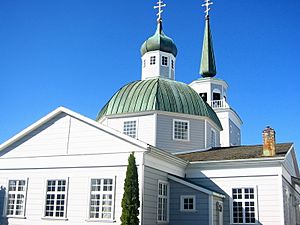
The Russian Orthodox religion was brought to Alaska by fur traders starting in the 1740s. In 1784, Shelikov brought the first official missionaries. This religious work continued into the 1800s. Today, it is the most visible sign of the Russian time in Alaska.
Spanish Claims
Spain also claimed Alaska, based on an old papal order from 1493. But they never built towns or forts there. Instead, they sent ships to explore and claim the area. In 1775, Bruno de Hezeta led an expedition. His ship, the Sonora, reached 58° north latitude. They entered Sitka Sound and claimed the area for Spain. In 1779, another Spanish expedition reached 61° north, the farthest north Spain ever went.
Britain's Presence
At this time, British settlements in Alaska were just a few trading posts. Most British people arrived by sea. Captain James Cook explored the west coast of North America in 1778. He sailed on HMS Resolution from California to the Bering Strait. During this trip, he found Cook Inlet in Alaska. The Bering Strait was too icy to pass through.
Cook's journey encouraged the British to sail more along the northwest coast. British posts in Alaska were run by the Hudson's Bay Company. These included Fort Yukon on the Yukon River, and other forts near the Taku River and Stikine River.
Alaska in the 19th Century
Later Russian Control (1799–1867)
A treaty in 1824 tried to stop American traders from going north of 54° 40' latitude. But many ignored it, and Russia's control over Alaska weakened. At its peak, the Russian population in Alaska reached about 700 people.
While the mid-1800s were tough for Russians in Alaska, things got better for the coastal Alaska Natives who had survived. The Tlingits were never fully conquered and kept fighting the Russians into the 1850s. The Aleuts' population dropped in the 1840s, but they eventually recovered.
The Alaska Purchase
Russia had money problems and wanted to keep Alaska out of British hands. Also, trade with Alaska wasn't making much money. These reasons made Russia willing to sell its land in North America.
The United States bought Alaska from Russia in 1867. All the businesses run by the Russian–American Company were then closed down.
Early U.S. Control (1867–1884)
The U.S. flag was raised in Alaska on October 18, 1867. This day is now called Alaska Day. The calendar also changed from the old Julian calendar to the Gregorian calendar. So, for people living there, Friday, October 6, 1867, was followed by Friday, October 18, 1867. This meant two Fridays in a row!
From 1867 to 1884, Alaska was managed by different parts of the U.S. government. First, it was under the U.S. Army until 1877. Then, the United States Department of the Treasury took over from 1877 to 1879. Finally, the U.S. Navy managed it from 1879 to 1884.
When the U.S. first bought Alaska, much of its land was still unknown. In 1865, Western Union started building a telegraph line across Alaska. This line was meant to connect, underwater, with an Asian line.
District of Alaska (1884–1912)
In 1884, Alaska was officially organized and renamed the District of Alaska.
In 1899, gold was found in Alaska itself, near Nome. This led to the building of new towns like Fairbanks and Ruby. In 1902, work began on the Alaska Railroad. It connected Seward to Fairbanks by 1914. Alaska still doesn't have a railroad connecting it to the rest of the U.S. But an overland route was built, making travel much faster.
Industries like copper mining, fishing, and canning became popular in the early 1900s. Some major towns had 10 canneries. In 1903, a border disagreement with Canada was finally settled.
By the early 1900s, commercial fishing grew in the Aleutian Islands. People salted cod and herring, and salmon canneries opened. Whaling continued without care for over-hunting. This pushed bowhead whales to the edge of extinction. The Aleuts faced big problems because fur seals and sea otters became scarce. They needed these animals for food and for boat skins to hunt. Americans also moved into Interior and Arctic Alaska. They used the furbearers, fish, and other game that Native people relied on.
Alaska in the 20th Century
Alaska Territory (1912–1959)
In 1912, Congress passed a new law. Alaska was reorganized and renamed the Territory of Alaska.
During the Great Depression, prices for fish and copper dropped. These were very important to Alaska's economy. The exploration and settlement of Alaska greatly benefited from the development of aircraft. Planes allowed many settlers to move into the state's interior. They also made it possible to transport people and supplies quickly.
World War II
During World War II, Japanese troops invaded and occupied two of the outer Aleutian Islands—Attu and Kiska. These were the only parts of the United States' main territory occupied by the enemy during the war. Getting them back became a matter of national pride.
On June 3, 1942, the Japanese attacked Dutch Harbor, a U.S. naval base. But U.S. forces fought them off. A few days later, the Japanese landed on Kiska and Attu. They captured the villagers on Attu and took them to Japan as prisoners for the rest of the war.
Attu was taken back in May 1943 after two weeks of tough fighting. The U.S. then focused on Kiska. From June to August, many bombs were dropped on the island. However, the Japanese managed to escape by ship. After the war, the Native Attuans who survived were moved to Atka by the government. Their home villages were considered too hard to defend.
In 1942, the Alaska–Canada Military Highway was finished. This road helped supply the Soviet Union across the Bering Strait. Running from Montana to Fairbanks, it was the first stable road link between Alaska and the rest of America. Building military bases, like the one on Adak, helped some Alaskan cities grow. Anchorage almost doubled in size, from 4,200 people in 1940 to 8,000 in 1945.
Statehood
By the early 1900s, people started pushing for Alaska to become a state. But lawmakers in the other 48 states worried that Alaska's population was too small and its economy too unstable. World War II and the Japanese invasion showed how important Alaska was strategically. This made the idea of statehood more serious.
The discovery of oil at Swanson River on the Kenai Peninsula finally changed how people saw Alaska. President Dwight D. Eisenhower signed the Alaska Statehood Act into law on July 4, 1958. This cleared the way for Alaska to join the U.S. on January 3, 1959. Juneau, the territorial capital, remained the state capital. William A. Egan became the first governor.
Alaska is different from most other American states. It doesn't have counties. Instead, it's divided into 16 boroughs and one "unorganized borough." Boroughs have their own governments. But in the unorganized borough, the state provides services. The unorganized borough is divided into census areas just for counting people.
On March 27, 1964, the Good Friday earthquake hit South-central Alaska. It shook the ground for four minutes with a magnitude of 9.2. This was one of the strongest earthquakes ever recorded. It killed 139 people. Most of them drowned in the tsunamis that destroyed the towns of Valdez and Chenega.
Oil and Land Politics (1968 – present)
Oil Discovery and the Trans-Alaska Pipeline
In 1968, oil was discovered at Prudhoe Bay on the North Slope. This oil field turned out to have the most oil of any in the United States. This discovery changed Alaska's politics for many years.
The oil discovery also brought the issue of Native land ownership to the forefront. In the mid-1960s, Alaska Natives from many groups had united to get back lands taken from them. But the government was slow to act until the Prudhoe Bay oil was found. Building a pipeline across the state was needed to get the oil to market. But this was stopped until Native land claims were settled.
In 1971, with huge oil money at stake, the Alaska Native Claims Settlement Act was signed into law. Under this Act, Native groups gave up their claims to land. In return, they received 44 million acres (180,000 km²) of land and $963 million. The money was divided among Native corporations.
A pipeline from the North Slope to the nearest ice-free port was the only way to get Alaska's oil to market. This port was almost 800 miles (1,300 km) to the south. Building the pipeline was a huge challenge. There were active fault lines, three mountain ranges, and miles of unstable, frozen ground. The Trans-Alaska Pipeline was finally finished in 1977. It cost $8 billion. The pipeline allowed a huge oil boom to begin.
Environmental Concerns and the Exxon Valdez
Alaska's land also had other economic value, like tourism. Tourism became popular after World War I. Soldiers stationed in Alaska returned home praising its natural beauty. The Alcan Highway, built during the war, and the Alaska Marine Highway System, finished in 1963, made the state easier to visit. Tourism became more and more important. Today, over 1.4 million people visit Alaska each year.
As tourism grew, environmentalism also became more important.
The possible environmental dangers of oil production became clear with the Exxon Valdez oil spill in 1989. On March 24, the tanker Exxon Valdez ran aground in Prince William Sound. It released 11 million gallons of crude oil into the water. The oil spread along 1,100 miles (1,800 km) of coastline. According to the U.S. Fish and Wildlife Service, at least 300,000 sea birds, 2,000 otters, and other marine animals died. Exxon spent $2 billion on cleanup in the first year alone.
Today, the debate between protecting nature and developing resources is seen in the Arctic National Wildlife Refuge (ANWR) drilling controversy. The question of whether to allow drilling for oil in ANWR has been a big political issue for every American president since Jimmy Carter.
Notable Historical Figures
- Alexander Andreyevich Baranov (1746–1819), a Russian trader and governor of Alaska.
- Edward Lewis "Bob" Bartlett (1904–1968), grew up in Fairbanks. He was a delegate to the U.S. House of Representatives and later a U.S. Senator. Many places in Alaska are named after him.
- Benny Benson (1913–1972), an Alaska Native from Chignik. He designed Alaska's flag at age 13.
- Vitus Bering (1681–1741), a Danish explorer for the Russians. He was the first European to reach Alaska.
- Jimmy Doolittle (1896–1993), grew up in Nome. He was a famous general in the United States Army Air Forces during World War II.
- Wyatt Earp (1848–1929), lived in Alaska from 1897 to 1901. He built the Dexter Saloon in Nome.
- William A. Egan (1914–1984), from Valdez. He was a merchant, mayor, and lawmaker. He was the first and fourth governor of Alaska.
- Carl Ben Eielson (1897–1929), a pioneering aviator.
- Ernest Henry Gruening (1887–1974), served as Governor of the Territory of Alaska from 1939 to 1953. He later became one of Alaska's first U.S. Senators.
- Jay Hammond (1922–2005), lived in rural southwest Alaska for many years. He was the fifth Governor of Alaska from 1974 to 1982. He was known for his conservation ideas.
- Saint Herman of Alaska (1756–1837), a Russian missionary. He was the first Eastern Orthodox saint in North America.
- Walter Hickel (1919–2010), a real estate developer. He was governor from 1966 to 1969 and again from 1990 to 1994. He also served as U.S. Secretary of the Interior.
- Sheldon Jackson (1834–1909), an American missionary and educator. He helped bring reindeer to Alaska from Siberia.
- Joseph Juneau (1836–1899) and Richard Harris (1833–1907), prospectors who founded what is now Alaska's capital city, Juneau.
- Austin Eugene "Cap" Lathrop (1865–1950), an industrialist. He started some of Alaska's oldest radio stations and built historic buildings.
- Loren Leman (born 1950), Lieutenant Governor from 2002 to 2006. He was the first Alaska Native elected to a statewide office.
- Ray Mala (1906–1952), the first Native American and first Alaskan to become a film star.
- John Muir (1838–1914), a naturalist, explorer, and conservationist. He helped create the first wilderness and forest preserves in Alaska.
- William Oefelein (born 1965), Alaska's first astronaut.
- Sarah Palin (born 1964), Alaska's youngest Governor and the first female Governor. She was also a Republican Vice Presidential nominee in 2008.
- Elizabeth Peratrovich (1911–1958), an Alaska Native of Tlingit heritage. She fought for laws that would prevent discrimination against Natives.
- George Sharrock (1910–2005), mayor of Anchorage during the 1964 Alaska earthquake in March 1964. He led the city's rebuilding efforts.
- Soapy Smith (1860–1898), known as "Alaska's Outlaw." He was a famous con man who ran the gold rush town of Skagway from 1897 to 1898.
- Ted Stevens (1923–2010), a U.S. Senator from Alaska from 1968 to 2009. He served longer than any other Republican Senator.
- Fran Ulmer (born 1947), Lieutenant Governor from 1994 to 2002. She was the first woman elected to statewide office in Alaska.
- Saint Innocent of Alaska (1797–1879), the first Russian Orthodox bishop in North America.
- Noel Wien (1899–1977), a pioneering aviator. He founded Wien Air Alaska and was the first to fly round trip between Alaska and Asia.
Images for kids
See also
 In Spanish: Historia de Alaska para niños
In Spanish: Historia de Alaska para niños


